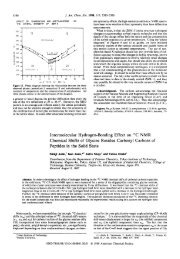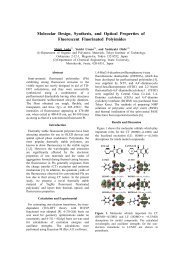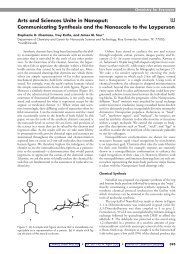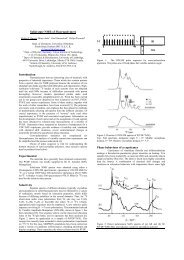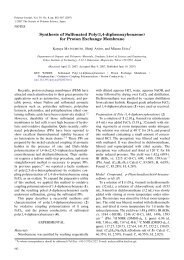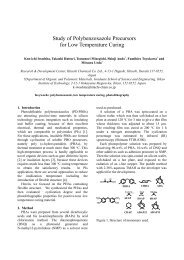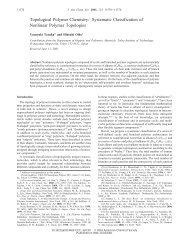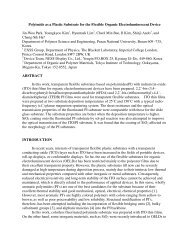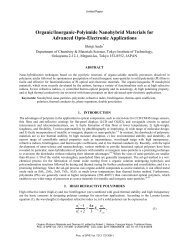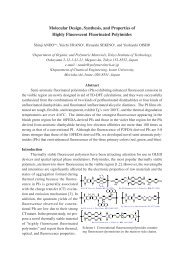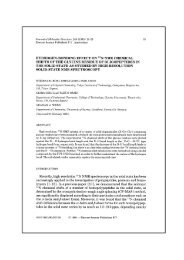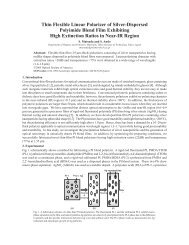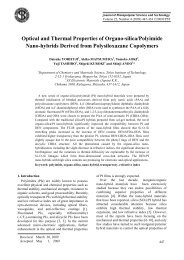Perfluorinated polymers for optical waveguides
Perfluorinated polymers for optical waveguides
Perfluorinated polymers for optical waveguides
You also want an ePaper? Increase the reach of your titles
YUMPU automatically turns print PDFs into web optimized ePapers that Google loves.
Table 1. Molecular structure and properties of amorphous and semicrystalline perfluoro<strong>polymers</strong><br />
(/X(I" (Cf~f,+.-<br />
F F F F<br />
~rf+ --{Cf,-Cf+<br />
Property<br />
F3C CF3 F F<br />
TellonAF<br />
Morphology<br />
Amorphous<br />
Fluorine content, wt % 67.1,65.0<br />
Glass transition temp., °c<br />
160, 240 a<br />
Melting point, °c<br />
Dielectric constant 1.89-1.93<br />
Refractive index 1.29-1.31<br />
Optical transmittance, % >95<br />
(visible region)<br />
a The glass transition temperature with no TFE content is higher than 300°C.<br />
Cytop<br />
PTFE<br />
Amorphous<br />
Semicrystalline<br />
67.9 76.0<br />
108<br />
327<br />
2.1-2.2 2.1<br />
1.35 1.38<br />
95 Opaque<br />
We first determined the reactivIties of the diamines<br />
shown in Figure 6 by synthesizing poly(amic acid)s using<br />
6FDA as the dianhydride. Note that 6FDA is not perfluorinated.<br />
The end-group contents of the poly(amic acid)s that<br />
were determined from 19F NMR are as follows:<br />
• 4FMPD tetrafluoro-m-phenylenediamine 15%<br />
• 4FPPD tetrafluoro-p-phenylenediamine 42%<br />
• 8PODA<br />
bis(2,3,5,6~tetrafluoro-4-<br />
75%<br />
aminopheny 1 )ether<br />
• 8FSDA bis(2,3,5,6-tetrafluoro-4-<br />
91%<br />
aminophenyl)sulfide<br />
• 8FBZ 4,4'-diaminooctofluorobiphenyl >99%<br />
Of these, 4FMPD shows the lowest end-group content, or<br />
the highest reactivity, and 4FPPD shows the next lowest<br />
end-group content.<br />
However, <strong>for</strong> all the diamines, the acylations were not<br />
complete, and end-group contents were still high even<br />
after 6 days of reaction at room temperature. When 8FBZ<br />
diamine, the least reactive one, was reacted with 6FDA, no<br />
NMR signal <strong>for</strong> the poly(amic acid) was detected. The<br />
electron-donating properties of the diamines, which determine<br />
the reactivity of diamines <strong>for</strong> acylation, matched the<br />
end-group contents of the poly(amic acid)s (20). We estimated<br />
the electron-donating properties from 15N NMR<br />
chemical shifts and from electron-related parameters such<br />
as ionization potential, electronic affinity, and molecular<br />
orbital energy.<br />
However, Hougham and co-workers at IBM have prepared<br />
continuous films using 6FDA as the dianhydride and<br />
4FPPD and 8FBZ as diamines (22). They showed that two<br />
Figure 6. These structures are used to<br />
synthesize perfluorinated polyimides.<br />
This perfluorinated dianhydride and the five<br />
perfluorinated diamines may be purchased<br />
or prepared by known procedures.<br />
F<br />
F F<br />
F<br />
4FPPD<br />
4FMPD<br />
F<br />
F F<br />
BFBZ<br />
F<br />
""*S*'"' ""*0*'",<br />
F F F F F F F F<br />
BFSDA<br />
BFODA<br />
24 CHEMTECH DECEMBER 1994



